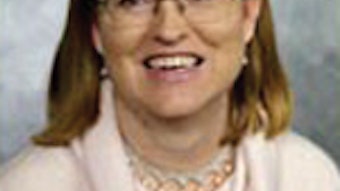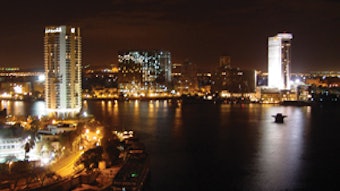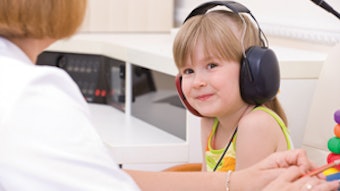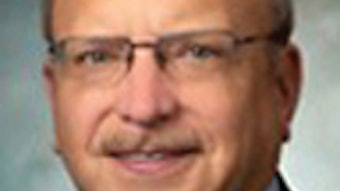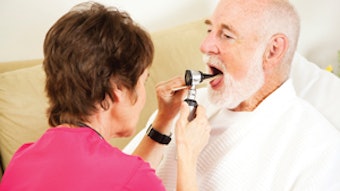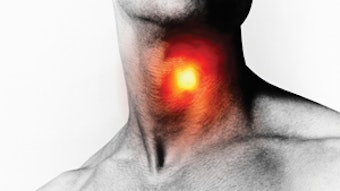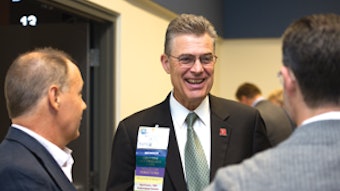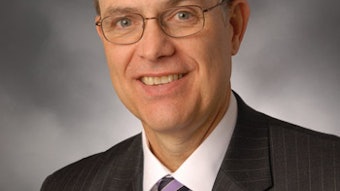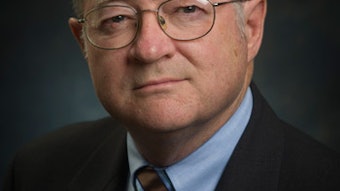Ethiopia Surgical Trip: Serving Local Physicians
Audrey P. Calzada, MD Clinical Fellow, Otology/Neurotology House Ear Clinic I had the privilege of traveling as part of the team led by Glenn Isaacson, MD, with Healing the Children to Ethiopia at the end of October. We spent two days in Addis Ababa giving lectures to the otolaryngology residents at Addis AbabaUniversity and seeing mostly children in a clinic at the mission hospital, CURE, and at the MakanissaSchool for the Deaf. We spent the remainder of the week in Mekelle, the third largest city in Ethiopia. We operated on and saw patients with Adamu Yilikal, MD, who is the only otolaryngologist in the northern half of the country, serving more than eight million people. The goal of our trip was to equip local surgeons to better serve their communities by providing equipment, clinical instruction, and operative teaching. Our team consisted of four otolaryngologists, one anesthesiologist, three audiologists, and the president of Healing the Children. We had the opportunity to provide and observe medical care in several different healthcare settings within Ethiopia: a non-profit mission hospital, a government hospital, and a mission school for the deaf. Visiting and working in each center allowed for comparing and contrasting the benefits and downfalls of each place in partnering to provide healthcare to the people of Ethiopia. We began our week at the mission hospital, CURE, which is a non-profit, privately funded surgical hospital for children in Addis Ababa with high standards of excellence. Because Dr. Isaacson and anesthesiologist Elizabeth Drum, MD, have led multiple teams there during the past five years, the clinic we ran consisted of both new and returning patients, who had previous operations by our team. The equipment, all donated and brought by surgical teams, was organized and sufficient. The flow of the operating room, directed by an anesthesiologist from the United States, was efficient and smooth. While this surgical hospital provides excellent, free care to children, the leadership is largely foreign-based and western-trained, which limits its ability to build local healthcare expertise. In contrast to CURE, the government hospital in Mekelle, where we performed otologic and head and neck cases with Dr. Yilikal, was poorly equipped and inefficiently run despite hard-working, intelligent staff. One main hindrance to safe operative care in Ethiopia is the absence of anesthesiologists with medical degrees. In addition to training Dr. Yilikal and his residents to perform essential otolaryngologic procedures, we provided surgical instruments and equipment. Despite working there for two years and being the only otolaryngologist in the region, he had instruments to perform only tonsillectomies prior to our visit. In addition to the lack of well-trained ancillary staff and equipment, there was also the issue of consistent electricity in this large government hospital. It was extremely humbling to realize the large amount of infrastructure required to perform safe operations. The Ethiopian leaders of the government hospital in Mekelle were overwhelmingly hospitable. Through discussions with them over meals in the evening, I was inspired by their simultaneous understanding of the plight of medical care in Ethiopia and their courage to continue seeking out opportunities to improve the standard of care. I began to better understand the issues developing countries face when their educated class chooses to live and work in other countries with more opportunities. Even if disregarding financial provision for their families and future educational opportunities for their children, there is a seemingly insurmountable ceiling of advancement within surgical subspecialties. Not only are opportunities to develop adequate surgical skills in quality training programs lacking, there is no support or equipment to build a meaningful practice. What impact can a practicing otolaryngologist in a community of eight million people make without a microscope, surgical instruments, and trustworthy anesthesia? These are issues that have been courageously and tirelessly addressed by Dr. Isaacson (Dr. Glenn, as he is known in Ethiopia) during the past six years. To detail the equipment and support provided to the Ethiopian otolaryngology community is one thing, but I was equally struck by his tenacity in dealing with the minute-to-minute issues we all faced with improvisation and patience. As my emotions regarding medical humanitarian work positively impacting a developing community wavered between hopelessness and optimism, I observed that our trip leaders were quietly and diligently changing the practice of otolaryngology in Ethiopia. As I complete my fellowship training, I desire to be useful in service to others, and I hope to partner with surgeons in other parts of the world to better serve their communities. I am thankful to the AAO-HNSF Humanitarian Committee for providing grant support for this trip. I return inspired and humbled by the attitudes and hard work of my colleagues both in this country and in Ethiopia.
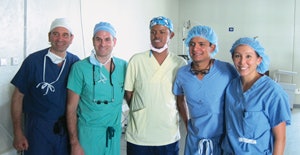 The surgical team in Mekelle, Ethiopia. From right to left, Audrey Calzada, MD, Gabe Calzada, MD, Adamu Yilikal, MD, Andrew Mallon, DO, and Glenn Isaacson, MD.
The surgical team in Mekelle, Ethiopia. From right to left, Audrey Calzada, MD, Gabe Calzada, MD, Adamu Yilikal, MD, Andrew Mallon, DO, and Glenn Isaacson, MD.Audrey P. Calzada, MD
Clinical Fellow, Otology/Neurotology
House Ear Clinic
I had the privilege of traveling as part of the team led by Glenn Isaacson, MD, with Healing the Children to Ethiopia at the end of October. We spent two days in Addis Ababa giving lectures to the otolaryngology residents at Addis AbabaUniversity and seeing mostly children in a clinic at the mission hospital, CURE, and at the MakanissaSchool for the Deaf. We spent the remainder of the week in Mekelle, the third largest city in Ethiopia. We operated on and saw patients with Adamu Yilikal, MD, who is the only otolaryngologist in the northern half of the country, serving more than eight million people. The goal of our trip was to equip local surgeons to better serve their communities by providing equipment, clinical instruction, and operative teaching.
Our team consisted of four otolaryngologists, one anesthesiologist, three audiologists, and the president of Healing the Children. We had the opportunity to provide and observe medical care in several different healthcare settings within Ethiopia: a non-profit mission hospital, a government hospital, and a mission school for the deaf. Visiting and working in each center allowed for comparing and contrasting the benefits and downfalls of each place in partnering to provide healthcare to the people of Ethiopia.
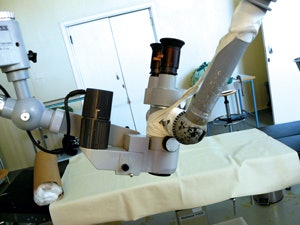 The 30-plus-year-old Zeiss microscope Dr. Yilikal performs otologic surgery with. Fancy taping maneuvers were required to correctly position the teaching arm of the microscope.
The 30-plus-year-old Zeiss microscope Dr. Yilikal performs otologic surgery with. Fancy taping maneuvers were required to correctly position the teaching arm of the microscope.We began our week at the mission hospital, CURE, which is a non-profit, privately funded surgical hospital for children in Addis Ababa with high standards of excellence. Because Dr. Isaacson and anesthesiologist Elizabeth Drum, MD, have led multiple teams there during the past five years, the clinic we ran consisted of both new and returning patients, who had previous operations by our team. The equipment, all donated and brought by surgical teams, was organized and sufficient. The flow of the operating room, directed by an anesthesiologist from the United States, was efficient and smooth. While this surgical hospital provides excellent, free care to children, the leadership is largely foreign-based and western-trained, which limits its ability to build local healthcare expertise.
In contrast to CURE, the government hospital in Mekelle, where we performed otologic and head and neck cases with Dr. Yilikal, was poorly equipped and inefficiently run despite hard-working, intelligent staff. One main hindrance to safe operative care in Ethiopia is the absence of anesthesiologists with medical degrees. In addition to training Dr. Yilikal and his residents to perform essential otolaryngologic procedures, we provided surgical instruments and equipment. Despite working there for two years and being the only otolaryngologist in the region, he had instruments to perform only tonsillectomies prior to our visit. In addition to the lack of well-trained ancillary staff and equipment, there was also the issue of consistent electricity in this large government hospital. It was extremely humbling to realize the large amount of infrastructure required to perform safe operations.
The Ethiopian leaders of the government hospital in Mekelle were overwhelmingly hospitable. Through discussions with them over meals in the evening, I was inspired by their simultaneous understanding of the plight of medical care in Ethiopia and their courage to continue seeking out opportunities to improve the standard of care. I began to better understand the issues developing countries face when their educated class chooses to live and work in other countries with more opportunities. Even if disregarding financial provision for their families and future educational opportunities for their children, there is a seemingly insurmountable ceiling of advancement within surgical subspecialties. Not only are opportunities to develop adequate surgical skills in quality training programs lacking, there is no support or equipment to build a meaningful practice. What impact can a practicing otolaryngologist in a community of eight million people make without a microscope, surgical instruments, and trustworthy anesthesia?
 The surgical team performing a tympanoplasty. From right to left, Drs. Calzada, Yilikal, and Mallon. In the background are junior otolaryngology residents from Addis Ababa.
The surgical team performing a tympanoplasty. From right to left, Drs. Calzada, Yilikal, and Mallon. In the background are junior otolaryngology residents from Addis Ababa.These are issues that have been courageously and tirelessly addressed by Dr. Isaacson (Dr. Glenn, as he is known in Ethiopia) during the past six years. To detail the equipment and support provided to the Ethiopian otolaryngology community is one thing, but I was equally struck by his tenacity in dealing with the minute-to-minute issues we all faced with improvisation and patience. As my emotions regarding medical humanitarian work positively impacting a developing community wavered between hopelessness and optimism, I observed that our trip leaders were quietly and diligently changing the practice of otolaryngology in Ethiopia.
As I complete my fellowship training, I desire to be useful in service to others, and I hope to partner with surgeons in other parts of the world to better serve their communities. I am thankful to the AAO-HNSF Humanitarian Committee for providing grant support for this trip. I return inspired and humbled by the attitudes and hard work of my colleagues both in this country and in Ethiopia.
